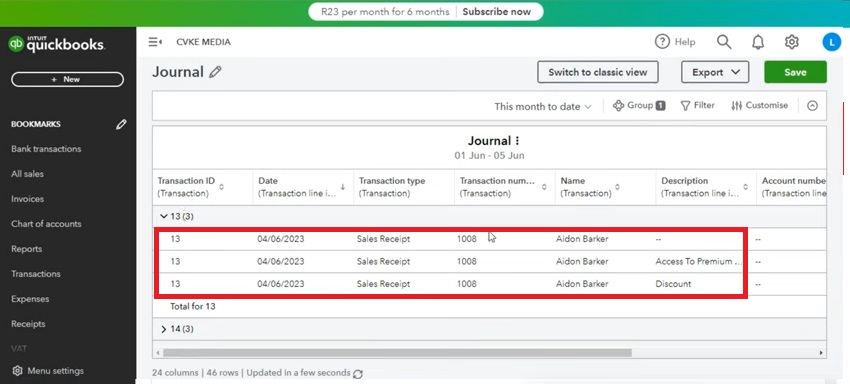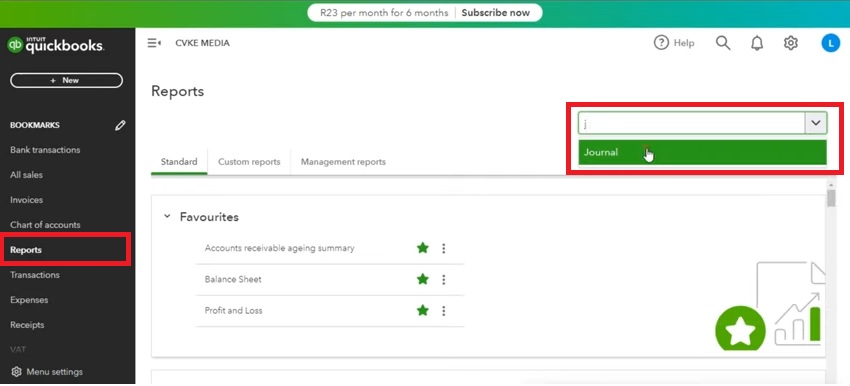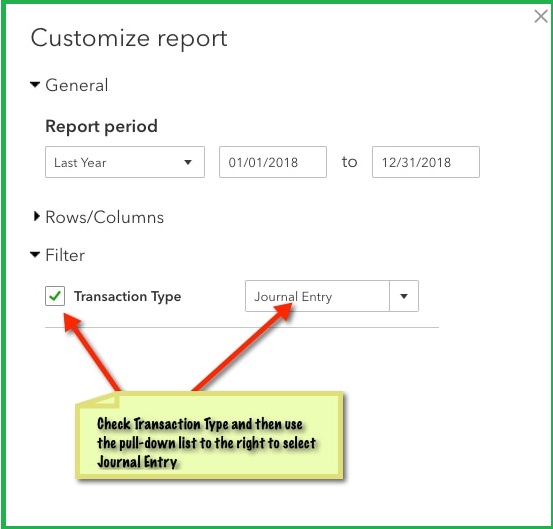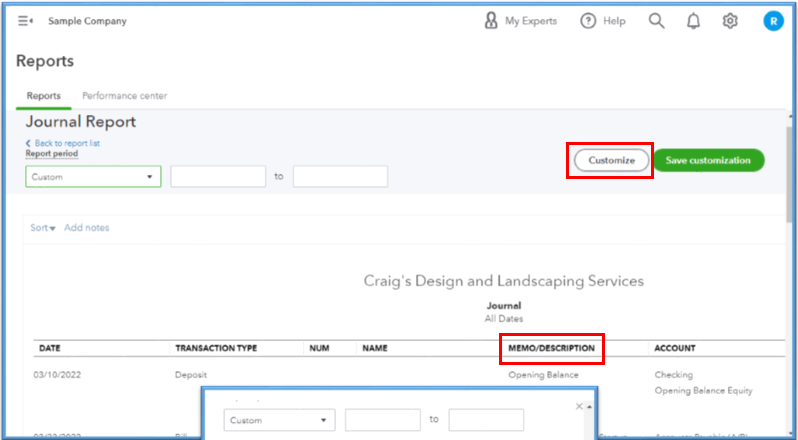Highlights (Key Facts & Solutions)
- Core Principle: All Journal Entries must adhere to double-entry accounting, meaning total Debits must always equal total Credits (Debits=Credits).
- QBO Primary View: The standard method to view JEs in QuickBooks Online is by running the Journal Report located under the For my accountant section.
- Finding Deleted Entries (QBO): Deleted JEs are reviewed by navigating to the Audit Log and filtering the Events by Deleted/Voided Transactions; deleted entries must be manually recreated.
- QBDT Old Entries: Older JEs in QuickBooks Desktop can be efficiently accessed directly from the Journal Entry screen by clicking the counterclockwise arrow icon and selecting View More.
- Reconciliation Warning: Never edit a Journal Entry linked to a reconciled transaction unless prepared to resolve the resulting reconciliation discrepancy, as this unbalances prior records.
- Exporting Data: The fastest way to export a clean list of JEs from QBO is by running the Journal Report and applying a Transaction Type filter set specifically to “Journal Entry.”
- Permissions: Only users with Admin or specific editing permissions can modify or delete existing Journal Entries in QuickBooks.
Overview
How to View Journal Entries in QuickBooks Online and Desktop? We’re here to simplify it. It is crucial to understand what journal entries are, how to find or make them in QuickBooks desktop/ Online, and why they are created. But before we get to the crux of the matter, let’s take a step-by-step approach.
What Are General Journal Entries & How Does It Work for QuickBooks?
A journal entry is used to record a company transaction in accounting records. Every business transaction must be recorded in at least two locations for a journal entry (double entry accounting) to make sense. You may manage your business accounts with the help of the QuickBooks software, which automates some accounting and financial management functions.
Basic QuickBooks online journal entry Format
| Account number/name | Debit | Credit |
| XXX | $xx ,xxx | |
| XXX | $xx ,xxx |
To maintain the balance of the accounting equation (Assets = Liabilities + Shareholders’ Equity), the debits and credits for each journal entry must be equal.
We must constantly take into account four aspects when creating journal entries:
- Which accounts the transaction has an impact on.
- Find out if the balance is increased or reduced for each account.
- Calculate the amount of change for each account.
- Maintain the equation for accounting’s balance.
How to View or Find Journal Entries in QuickBooks Online?
To view journal entries in QuickBooks Online, use the Advanced Search option or access them via the Audit Log. The Advanced Search allows for detailed filtering, while the Audit Log tracks all system events, making it easy to find and review specific journal entries. Follow Step by Step Guide Listed Below:
Step 1. Log in to your QuickBooks Online Account
Navigate to the QuickBooks Online website and enter your credentials to log in to your QuickBooks Online account.
Step 2. Select the Appropriate Company File
If you manage multiple companies, ensure you choose the correct one to view its journal entries.
Step 3. Navigate to the Reports Section
Look for the “Reports” option in the left-hand menu on the dashboard and click on it to access various reporting tools.
Step 4. Scroll Down to the ‘For my accountant’ Section
In the ‘Standard’ tab, scroll down to the ‘For my accountant.’ It contains reports that are particularly useful for accounting purposes, including journal entries.
Step 5. Click on the Journal Report Option
Selecting the journal report option will open a detailed report specifically for journal entries, which will allow you to view all relevant transactions.
Step 6. Set the Date Range for the Journal Entries
Use the date filters to customize the reports according to the specific period you want to analyze.
Step 7. Open and View a Detailed Journal Entries List
Once the report is generated, you can see all journal entries within your specified date range, including details such as dates, amounts, and accounts involved.


How to View Journal Entries in QuickBooks Online via Audit Log?
Users can access journal entries through the audit log. It is a systematic process which allows users to track changes made to the journal entries and provides transparency and accountability.
Steps to view journal entries via audit log:
Step 1. Opening the Audit Log
Click on Settings at the top right corner of your interface. Choose Audit Log to open the audit log interface from the drop-down menu.
Step 2. Filtering Results
Utilize filter options to simplify your search. You can filter results by:
- User: Identify changes made by specific users.
- Date: Narrow down changes to a particular time frame.
- Event Type: Focus on specific types of events related to journal entries.
After setting your desired filters, click Apply to view the relevant records.
Step 3. Reviewing Changes
The audit log will present a complete history of changes made to journal entries, which contains details such as:
- Who Made Changes: Information about the user who performed each action.
- When Changes Occurred: The exact date and time of each modification.
Select View in the History column adjacent to individual entries for a deeper dive into specific entries. This action will provide detailed insights into what changes were made.
How to View the Journal Entries in QuickBooks Online via the Advanced Search Option?
QuickBooks offers the Advance Search option to view the journal entries in QuickBooks Online via Advance Search:
Step 1. Launch QuickBooks Online
Open the QuickBooks Online application on your device.
Step 2. Locate the Search Icon
Find the magnifying glass icon, typically located at the top right corner of the interface.
Step 3. Select Advanced Search
Click on the magnifying glass icon, then choose the Advanced Search link from the dropdown menu.
Step 4. Choose Journal Entries Type
In the advanced search menu, look for the option to select Journal Entries. Select Journal Entries from the available options.
Step 5. Set Filters
You can further refine your search by:
- Entering a custom date range.
- Specifying a reference number, if applicable.
- Selecting a customer or entering an amount related to the journal entry.
Step 6. Review Results:
After setting your filters, click on the search button to display the relevant journal entries that match your criteria.
Become An Expert With QuickBooks Training & Certification and master the above skills in no time. With the following course you can easily learn to view the journal entries in QuickBooks.
how to see journal entries in quickBooks online?
You can run Journal reports to see your saved journal entries in QuickBooks Online, follow further simple steps below:
- Log in to QuickBooks Online.
- From the left-hand menu, click on the ‘Reports’ section.
- Scroll to the ‘For my accountant’ category and select ‘Journal.
- Use the available search and filter options to refine your view. You can filter by date, amount, or account to find specific journal entries.
- Once customized, the report will display all the relevant journal entries.
This process ensures you can easily locate and see any saved journal entries in QuickBooks Online.
How to Find all Journal Entries in QuickBooks Online?
How to View All Journal Entries in QuickBooks Online Finding all journal entries in QuickBooks Online is simple using the Reports feature. Here’s how:
- Log in to your QuickBooks Online account.
- Click Reports from the left-hand menu.
- Scroll down to the For My Accountant section.
- Select Journal to view all journal entries.
- Customize the report by adjusting the date range, transaction type, or columns.
- Click Refresh Report to update the view.
- You can also export, print, or email the report for easy sharing.
How to View Previous Journal Entries in QuickBooks Online
To find past journal entries in QuickBooks Online, you can use the Journal Report. This report provides details like dates, accounts, amounts, and memos for all journal entries.
- Steps to View Previous Journal Entries:
- Log in to QuickBooks Online.
- Click Reports from the dashboard.
- Search for Journal Report.
- Use the date filter to select a specific time range.
- Click Run Report.
How to View General Journal Entries in QuickBooks Online?
To see journal entries in QuickBooks Online, follow these simple steps:
- Log in to QuickBooks Online.
- Click Reports in the left menu.
- Scroll to the For My Accountant section.
- Select Journal to open the report.
- Use the date filter to choose a time range.
- Click Run Report to view the entries.
search journal entries in QuickBooks Online
How to Run a Journal Entry Report in QuickBooks Online
To run a journal entry report in QuickBooks Online:
- Go to Reports – In the left menu, click Reports.
- Find the Journal Report – Use the search bar and type “Journal”, then select Journal Report.
- Set the Date Range – Choose the appropriate time frame for your report.
- Customize if Needed – Click Customize to filter by account, transaction type, or other criteria.
- Run the Report – Click Run Report to view the journal entries.
- Export or Print – Use the icons in the top right to export as PDF/Excel or print.
How to review journal entries in QuickBooks Online
- Open QuickBooks Online – Log in to your QuickBooks Online account.
- Go to Reports – Click on “Reports” in the left menu.
- Find the Journal Report – Use the search bar to type “Journal”, then select the report.
- Set the Date Range – Choose the appropriate date range to filter the entries.
- Review Entries – Check the accounts, debits, and credits for accuracy.
- Drill Down for Details – Click on any journal entry to open and review it.
- Edit if Needed – Click “Edit” to make changes or “More” > “Audit History” to see past modifications.
How to Export Journal Entries from QuickBooks Online
Exporting journal entries from QuickBooks Online is simple. Follow these steps:
Step 1: Sign in to QuickBooks Online
- Log in to your QuickBooks Online account.
- Make sure you have the necessary permissions to export data.
Step 2: Access the Reports Section
- Click on Reports in the left-hand menu.
- Use the search bar to find Journal or Transaction List by Date report.
Step 3: Customize the Report
- Set the date range to include the journal entries you need.
- Filter the report to show only journal entries by selecting Transaction Type > Journal Entry.
Step 4: Export the Report
- Click the Export button at the top of the report.
- Choose Export to Excel or Export to PDF, depending on your preference.
Step 5: Save and Review
- Save the exported file to your computer.
- Open it to ensure all necessary journal entries are included.
Step 6: Use the Exported Data
- You can now share, print, or import the journal entries into another system if needed.
That’s it! You’ve successfully exported journal entries from QuickBooks Online. Let me know if you need further assistance.
How to View Deleted Journal Entries in QuickBooks Online
Accidentally deleted a journal entry in QuickBooks Online? Don’t worry! You can still review deleted transactions using the Audit Log. Follow these steps to find and review deleted journal entries:
Step-by-Step Guide:
- Log in to QuickBooks Online
- Open QuickBooks Online and sign in to your account.
- Access the Audit Log
- Click on the Gear icon (Settings) in the top-right corner.
- Select Audit Log under the “Tools” section.
- Filter for Deleted Transactions
- Click the Filter button.
- Choose “Deleted/Voided Transactions” from the “Events” dropdown.
- Select the appropriate date range.
- Click Apply to view results.
- Locate the Deleted Journal Entry
- Find the deleted journal entry in the list.
- Click View to see the details of the deleted entry.
- Recreate the Journal Entry (If Needed)
- If you need to restore the entry, note down the details.
- Go to + New > Journal Entry and re-enter the details manually.
How to Edit or Modify Journal Entries in QuickBooks Online
Journal entries help keep your books accurate, but sometimes, you may need to make changes to correct errors or update records. QuickBooks Online allows you to edit or modify journal entries easily.
Steps to Edit a Journal Entry in QuickBooks Online
- Log in to QuickBooks Online and navigate to the Settings (Gear icon).
- Click on Chart of Accounts and locate the account associated with the journal entry.
- Open the Account History and find the journal entry you want to edit.
- Click on the journal entry number to open it.
- Make the necessary changes (date, accounts, amounts, or descriptions).
- Click Save and Close to update the entry.
Things to Keep in Mind
- Only admin users or those with necessary permissions can edit journal entries.
- If the entry is linked to a reconciled transaction, modifying it may affect your reconciliations.
- If you’re unsure about changes, consult an accountant before making edits.
Alternative: Delete and Recreate a Journal Entry
If an entry is incorrect beyond simple edits, it’s best to delete and re-enter it.
- Follow steps 1-4 above to locate the entry.
- Click More at the bottom and select Delete.
- Create a new journal entry by going to + New > Journal Entry, then enter the correct details.
Final Tips
- Double-check edits to ensure accuracy.
- Keep a backup or note of original entries before making major changes.
- Review reports after modifications to confirm the correct updates.
By following these steps, you can easily manage and correct journal entries in QuickBooks Online, keeping your financial records accurate and up to date.
How to View or Find Journal Entries in QuickBooks Desktop?
To view journal entries in QuickBooks Desktop, go to the Reports menu and select “All Journal Entries.” For older entries, use the Journal Entry option under “Create,” then click the counterclockwise arrow and “View More” to access and filter past entries. Follow step by step Instructions below:
All of your journal entries are saved in your account by QuickBooks. The simplest method is to go to the Reports menu and choose All Journal Entries. You may access the relevant journal entries from this point.
- Go to the left side and click on Reports to start.
- Then, you must look for the journal in the relevant search box.
- Press the drop-down menu labeled “Month-to-date” below the specific report period.
- Select Custom.
- Edit the date range to include the start and end dates for the period you want to view the journal entries.
- To update the specified report, click anywhere on the relevant page.
- You may do this to view QuickBooks Desktop’s journal entries.
How to view the Old Journal Entries in QuickBooks Desktop Applications?
You might need to verify the old QuickBooks journal entries if you find an issue during account reconciliation.
- Firstly, click on the Create button in the upper right corner.
- Then, press Journal Entry.
- You must now choose the symbol with the counterclockwise arrow. The top-left corner will have this arrow there.
- Then click View More.
- Finally, you will be able to see see all journal entries in QuickBooks online. In addition, you may filter them if you need specific data.
How to Find/View List Of journal entries in quickBooks online?

To view list of journal entries in QuickBooks Online, follow these simple steps:
Step 1. Access the Reports Section:
Start by navigating to the Reports section from the left-hand panel of your QuickBooks Online dashboard.
Step 2. Select the Journal Report:
In the search bar or within the reports menu, find and click on the Journal report. This report will provide a complete overview of your journal entries.
Step 3. Customize Your Report:
Once the report window opens, click on the Customize button to filter specific journal entries. This allows you to customize the report to your needs.
Step 4. Set the Date Range:
In the customization options, set the Date range to include old journal entries for your desired reporting period.
Step 5. Filter by Transaction Type:
From the Filter dropdown, check the box for Transaction Type, then select Journal Entry type to focus solely on journal entries.
Step 6. Run the Report:
After applying your filters, click on Run Report. This will generate a list of all journal entries that match your criteria, including any notes in the MEMO/DESCRIPTION column.

Once the report is generated, you can easily see a list of your journal entries in one place for better financial management.
The Bottom Line
In QuickBooks, the journal entry plays a significant role. This makes it easier for you to record many transactions and upload them straight to the general ledger. If you wish to access a journal entry after generating or removing it, use the following methods.
The use of the Advanced Search, Audit Log, and Reports menus to view journal entries in QuickBooks Online and QuickBooks Desktop has been covered in this blog. You should now be able to comprehend the specifics, in case of any doubts feel free to connect with Accounting and Bookkeeping experts.
FAQs
1. What are the three primary methods for locating a Journal Entry in QuickBooks Online?
QuickBooks Online provides three distinct methods to locate a specific Journal Entry, catering to different search needs and security levels:
- Reports Section: This is the most common method. You run the Journal Report, found under the For my accountant section, and filter by date, account, or amount.
- Advanced Search: You can use the magnifying glass icon and select Advanced Search, setting the transaction type filter to Journal Entries to quickly find entries based on reference number or custom date ranges.
- Audit Log: This method tracks system events and is ideal for finding entries that were recently modified, created, or deleted (as detailed in FAQ 3).
2. How can I ensure I am viewing all Journal Entries for a specific period in QuickBooks Desktop?
To ensure you view all Journal Entries (JEs) for a custom or specific period in QuickBooks Desktop, you should use the Report Menu and customize the date range.
The steps are:
- Go to the Reports menu and search for Journal.
- Select the relevant Journal Report option.
- Press the drop-down menu labeled “Month-to-date” below the specific report period.
- Select Custom.
- Edit the date range to include the start and end dates for the period you want to view the journal entries.
- Click anywhere on the relevant page to update the specified report.
The Journal Report captures all debits and credits posted via a JE, making it the most reliable list.
3. If I accidentally delete a Journal Entry in QuickBooks Online, how can I find the transaction details to recreate it?
Accidentally deleted Journal Entries cannot be restored directly but can be fully reviewed using the Audit Log feature, which records all system actions.
The process is:
- Navigate to the Gear Icon ➜ Audit Log.
- Click the Filter button.
- In the Events dropdown menu, select Deleted/Voided Transactions.
- Find the deleted entry in the resulting list, which shows who deleted it and when.
- Click View to see the transaction details before deletion, allowing you to manually re-enter the JE as a new transaction.
4. What critical accounting rule must I remember when viewing or creating a Journal Entry?
The most critical accounting rule for any Journal Entry is the concept of double-entry accounting, which mandates that the accounting equation remain balanced.
This means:
- Debits equal Credits: The total amount entered in the Debit column for a single transaction must always equal the total amount entered in the Credit column.
- Equation Balance: This ensures that assets equal liabilities plus equity (Assets =Liabilities + Shareholders’ Equity) after the transaction is recorded.
If the Debit and Credit columns are not equal, the system will prevent you from saving the Journal Entry.
5. What are the key things to keep in mind before editing a Journal Entry in QuickBooks Online?
Before editing an existing Journal Entry, you must proceed with caution because altering a JE can have immediate and retroactive effects on your financial reports and ledger integrity.
Key considerations are:
- Reconciliation Status: If the JE is linked to a reconciled transaction, modifying it will cause your previous bank reconciliation to become unbalanced, requiring you to resolve a discrepancy.
- User Permissions: Only Admin users or those with the necessary editing permissions can modify or delete Journal Entries; standard users cannot.
- Audit Trail: Every edit is tracked in the Audit Log, ensuring transparency regarding who changed the entry and when.
If the change is significant, it is generally recommended to delete and recreate the entry instead of making complex edits.
6. How can I efficiently access very old Journal Entries in the classic QuickBooks Desktop application?
The most efficient method to view older Journal Entries in QuickBooks Desktop without relying solely on the Reports menu involves using the entry screen itself.
The quick process is:
- Click the Create menu and select Journal Entry.
- Once the JE screen is open, locate and click the counterclockwise arrow icon, usually found near the top-left of the screen.
- Click View More to pull up a list of past JEs, where you can filter by date or number to quickly jump to the transaction you need to verify.
This method is faster than running and filtering a general report if you know the approximate date or reference number.
7. What is the fastest way to generate an exportable list of Journal Entries in QuickBooks Online?
The fastest way to generate a list of JEs that can be exported (e.g., to Excel or PDF) is by using the Reports menu and then applying two specific filters.
The process is:
- Go to Reports and select the Journal Report.
- Set the required Date Range.
- Under the Customize options, filter by Transaction Type and select Journal Entry.
- Click Run Report.
- Use the Export icon (usually a sheet icon) at the top of the report to choose your preferred format (Excel or PDF).
Filtering by transaction type ensures the report only contains JEs, which streamlines the export process for external use.
